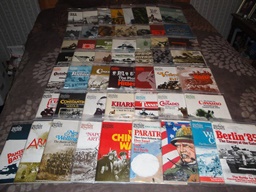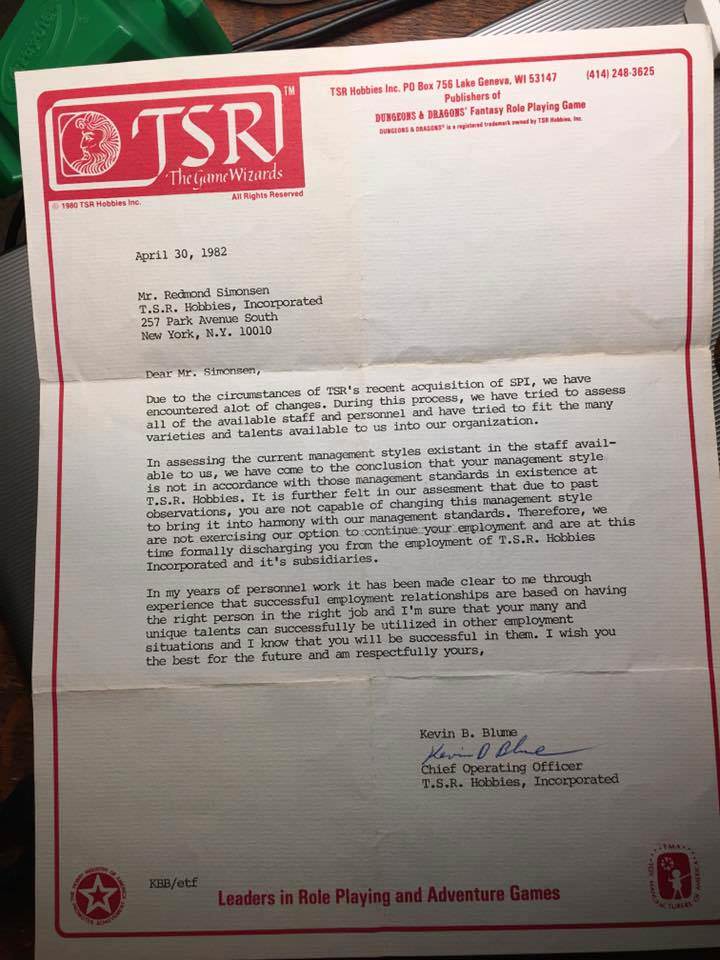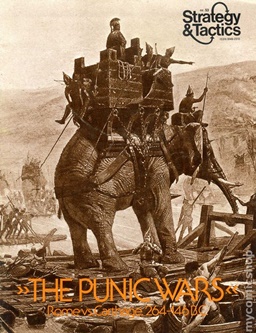Simulations Publications Inc: The TSR Incursion
Around the end of 1981, brothers Kevin and Brian Blume wrested control of TSR away from founder Gary Gygax. The company would change dramatically under their leadership, until Gygax returned from his west coast exile in 1984 and (briefly) reclaimed his company. One ‘Blume Incident’ from 1982 is a pretty good example of the way they did things.
In 1958, Avalon Hill was formed, creating the modern wargaming industry, out of which role playing games grew. In 1969, James Dunnigan created Simulations Publications, Inc. — to be known as SPI — with Redmond Simenson as co-founder. He started the company to save an existing wargaming fanzine, Chris Wagner’s Strategy & Tactics, which was in a precarious financial state. Simenson was the graphic designer for the magazine and a huge part of its success. For the princely sum of $1 (yes, you read that right), SPI took on Strategy and Tactics and made it the industry’s leading newsletter, starting with the September, 1969 issue.
Strategy & Tactics would include a new wargame in every single issue from then through the current one, which is remarkable. With the popularity of the magazine, SPI also became Avalon Hill’s major competitor in the wargaming market and enjoyed great success in the seventies. Things were good. Then, as for JFK, came Dallas. Okay, not quite.
Dunnigan’s Dallas: The Television Roleplaying Game, was a licensed product, intended to cash in on the massively successful show. My first thought is to wonder how many Dallas fans wanted to play an RPG — apparently not many. It was a disaster. Simonsen commented that they produced “80,000 copies and that was 79,999 too many.”
 He later said that a declining games market combined with a lack of business expertise in the company was too much for SPI to overcome. Too much money was tied up in inventory and cash flow was insufficient. There’s no denying that the company was in poor financial condition in 1980 and Dunnigan was forced to resign.
He later said that a declining games market combined with a lack of business expertise in the company was too much for SPI to overcome. Too much money was tied up in inventory and cash flow was insufficient. There’s no denying that the company was in poor financial condition in 1980 and Dunnigan was forced to resign.
Things got worse and SPI was forced to sell five of its games to Avalon Hill for a quick infusion of cash. That must have been a particularly bitter pill to swallow. Their competitor pondered buying SPI out, but chose instead to offer to buy most of the company’s games. SPI, still trying to remain a viable entity, refused to sell. At Christmas of 1981, President Chris Wagner (the creator of Strategy & Tactics who had sold it to SPI for $1) borrowed approximately $360,000 from a group of venture capitalists.
The death blow came in 1982 and it would be delivered by Brian Blume, who initially looked like a white knight. Well, at least a moderately gray one. Wagner and SPI secured a $425,000 loan from TSR, secured by its assets and intellectual properties (uh oh!).
The majority of the loan was used to repay the venture capitalists, which eliminated that problem, but it was the modern day equivalent of getting an advance on your credit card to pay down the existing balance on another credit card. You still have to pay off that second credit card advance.
Only two weeks later, TSR called in the loan, which SPI had absolutely zero ability to pay back. TSR announced in March that it had “initiated a legal and economic chain of events” to buy SPI. Once it realized the company’s debt situation, it backed off of that and stated that TSR had acquired the company’s assets, but not its debts. I’m still not sure how TSR got away with that.
WOW! How can you look at it in any other light than that TSR lent the money so it could immediately foreclose on SPI and acquire all its games? I mean, yeesh.
SPI was effectively dead. TSR couldn’t produce most of the games it acquired because the printers were owed a total of $40,000 and wouldn’t release the plates. TSR paid off the debts a year later but it had lost the ability to quickly publish the new properties, which would have generated cash. When combined with the debt, the acquisition of the games was initially a loss, not a gain.
TSR also refused to honor lifetime subscriptions to Strategy & Tactics. That certainly had to alienate a lot of the most promising customer base. I can only imagine that the Blumes saw it as an easy way to save some money, but it was a short-sighted move.
A week after TSR announced the acquisition of SPI, eight employees quit, forming Victory Games, which was a subsidiary of rival Avalon Hill. A bit later, Greg Costikyan and Eric Goldberg left and had successful careers at West End Games.

Simonsen was fired just one month after the acquisition — it was a picture of his dismissal letter that prompted this post. Simenson was the fifth inductee into the Charles S. Roberts Hall of Fame, which is for military wargaming (Dunnigan was the third member). It was an ignominious ending to a successful career at SPI.
He formed a computer game company, Ares Development Corporation, but it folded when Texas Instruments backed out of the computing business, nullifying a multi-game deal. His next project was a company that made peripherals for the Amiga computer. You can guess how that worked out.
The SPI brand periodically appeared on TSR wargames throughout the rest of the decade, but the company was effectively finished in 1982 when TSR recalled the loan. I play Munchkin with a friend who likes to put me in a losing situation, then offers to help me out of it for a hefty share of the treasure. I liken that to setting me on fire, then offering to sell me the use of his fire extinguisher. That’s the kind of feeling I have about TSR’s loan.
Shannon Appelcline made this observation:
As for SPI, its passing truly marked the end of an era. Where once wargames ruled the hobbyist game scene, now roleplaying games took over. More than anything, the TSR purchase of SPI represented the passing of this torch.
Strategy & Tactics
 Very little that was SPI survived the TSR incursion (that sounds like a good name for a sci-fi novel). Strategy & Tactics both preceded SPI and outlasted it.
Very little that was SPI survived the TSR incursion (that sounds like a good name for a sci-fi novel). Strategy & Tactics both preceded SPI and outlasted it.
In 1967, Chris Wagner thought that he could come up with something better than Avalon Hill’s gaming magazine, The General. With graphic designer Redmond Simonsen producing quality work, Strategy & Tactics was initially successful. But fanzines were and are a tough business and Wagner couldn’t carry on by issue 17. He sold the magazine for $1 to James Dunnigan and SPI. SPI published Strategy & Tactics from issues 18 through 89, with SPI producing 90 but it appeared under TSR’s banner.
TSR put out Issues 91 to 111, with 3W (World Wide Wargames) buying the rights and putting out issues 112 to 139. Decision Games purchased it and has published the magazine continuously since issue 140 (currently using the Decision Games imprint, Strategy & Tactics Press). It is still published with a game in each issue, but there is also a cheaper version that does not include the game.
Looking at the current website, and acknowledging it is owned by a wargaming company and each issue includes a game, it presents itself as a military history magazine, not a wargaming one.
Strategy & Tactics Press was founded in 1991 with the purchase of Strategy & Tactics, the longest running military history magazine (since 1967). Our readers get much more than historic narrative with our analytical approach focusing on the “how” and “why”‘ of battles and campaigns. All feature articles are lavishly illustrated with maps and historic images, along with sidebars on personalities, equipment, organization, and unique events.’
Shannon Appellcline’s four-volume history of Role Playing games, Designers and Dragons, is a marvelous resource and I used it for this post. I highly recommend checking it out. Full of great reading.
Prior RPG-related posts I’ve done here at Black Gate:
RPGing is Storytelling
Dungeon Delving Tips – Part I
Dungeon Delving Tips – Part II
Successful Dungeon Adventuring
Swords & Wizardry vs. Pathfinder
Swords & Wizardry Kickstarter
Perilous Vistas from Frog God Games
The Lost Lands for Pathfinder
The Northlands Saga – Complete
The Warlords of the Accordlands
Judges Guild Premium Editions
Gary Gygax’s Role Playing Mastery
Everything You Ever Wanted to Know About the Temple of Elemental Evil
The Village of Hommlet
Munchkin!
Runebound
Runebound – The Sands of Al-Kalim
Runebound – The Mists of Zangara
Necromancer Games (Part One of two)
Frog God Games (Part Two of two)
Dungeons and Dragons Adventure Game System
D&D Adventure Game System – Temple of Elemental Evil
Dungeon! Board Game
Conan: Age of Exiles
Steve Russell of Rite Publishing – RIP
The Art of Dungeons & Dragons Kickstarter
Astonishing Swordsmen & Sorcerors of Hyperborea – 2nd Edition
Fox Trot’s Dungeons & Dragons
Mount & Blade Warband – Part One
Mount & Blade Warband – Part Two
Bob Byrne’s ‘The Public Life of Sherlock Holmes’ column ran every Monday morning at Black Gate from March 10, 2014 through March 20, 2017. He also organized Black Gate’s award-nominated ‘Discovering Robert E. Howard’ series.
He is a member of the Praed Street Irregulars, founded www.SolarPons.com (the only website dedicated to the ‘Sherlock Holmes of Praed Street’) and blogs about Holmes and other mystery matters at Almost Holmes.
He has contributed stories to The MX Book of New Sherlock Holmes Stories – Parts III, IV, V and VI and will be in IX if he quits having fun writing Black Gate posts and works on a story!
Wow – does this take me back. For me, SPI wargames are as much a part of the 70’s as Gerald Ford, Jimmy Carter, gas lines, KISS records, and the Symbionese Liberation Army. I still have all of mine and I pull one out occasionally. They hold up better than anything else I just mentioned. (Except the KISS records.)
The SPI masterminds’ big mistake was in thinking that paper map and counter wargames could ever be anything but a niche (and a small one at that) hobby. Certainly the same folks who hyperventilated over the question of who shot J.R. were not going to spend 20 hours refighting the War of the Spanish Succession.
The niche is still around, though, and doing fine. I have a package on its way to me right now that will put me right there with Stonewall Jackson at Cedar Mountain. Only this time, I will make the decisions! I can hardly wait…
Thomas – Howard Andrew Jones is a huge fan of the microgames from Victory Point Games. I haven’t quite been able to pull the trigger on one for the price.
John O’Neill was a big Ares fan. I suspect he’s got a plethora of their games in his collection.
I actually just picked up a copy of SPI’s John Carter, Warlord of Mars, although I have no idea when I’ll actually play it …
And although I remember hearing about the SPI acquisition in the pages of Dragon Magazine, it was obviously a fairly … sanitized version of the events that actually took place; I had no idea until I read this article.
I have (virtually) all of SPI’s fantasy and science fiction games, and a smattering of their historical games. I think my favorite SPI game is SPIES!, a fast-paced game of WWII espionage. With the right amount of players, that game is a blast.
I think a copy of OGRE is the only microgame I’ve got these days. I keep eyeing the PC version on Steam but it’s never on sale.
Thomas, wargaming is alive and well. Anyone interested should check out GMT Games. Their production values are top notch.
John, i’m sure you’ve got a copy of SPI’s War of the Ring still in shrink…along with the two mini games Sauron and Gondor.
WAR OF THE RING was (I think) the first SPI game I ever bought, in 1978. I played the heck out of that thing with my friend Chung Ming Tam in Ottawa. The three-way variant (with Sauruman as the 3rd player) was my favorite.
I spent way to much money buying an unpunched (but not, tragically, still shrinkwrapped) copy about 20 years ago. And yes, I have the mini-games Sauron and Gondor.
I also liked SPI’s microgames, like THE CREATURE THAT ATE SHEBOYGAN and DEMONS. I played the former with my son Drew when he was a pre-teen, and he loved it.
I still have my “designer’s edition” (the one with mounted maps) of War of the Ring – never mind that the designer in question, Richard Berg, pronounced it “unplayable.”
That one, Thomas?
In the wargames neighborhood, The Magic The Gathering boardgame, Planeswalkers, was recently discontinued and is selling all over America fro $5 (except Amazon, who pushed the price back up..). The base game and two expansions come with a bunch of quality minis and it’s well worth the price for them alone.
It’s a tactical minis game and I’ve seen several comments at BoardGame Geek that it’s similar to Heroscape.
Tactical minis fans might check it out. I’ve bought a total of five sets for $30 so far. The hex grid mats are also pretty cool.
Here’s a link to a standalone expansion (with 24 minis). I’ve seen it in stores like Ollie’s Warehouse and Five Below for $5.
https://www.kidswhs.com/magic-the-gathering-arena-of-the-planeswalkers-shadows-over-innistrad-game/
That’s the one, John! How did you get it? I could have sworn it was in my garage…
Bob,
This is a fantastic article. I love behind-the-scenes history like this, especially about the RPG industry.
Thanks Jackson. I like this stuff too. I’m going to try and write one up on the Secret Service raid on Steve Jackson Games.
Did you see my two part history on Necromancer/Frog God Games (links above)? That tracks the evolution of Necromancer and how it rebirthed as Frog God.
It is part of the 70s and my youth for me, as well. And I still have a dozen or so. I particularly loved the original versions of what became the PRESTAGs games, such as Phalanx. And I do love and still have SPIES!.
Bob,
Pretty much what Jackson said. Thanks for the excellent read.
[…] (Black Gate): “Around the end of 1981, brothers Kevin and Brian Blume wrested control of TSR away from […]
Thanks Zhern. This kind of thing is yet another topic I could write post after post about. If I didn’t need to hold down a job, pay the mortgage, provide health insurance for the family -you know, life.
But I should definitely be able to do a piece on the Steve Jackson/Secret Service thing.
And probably one on Gygax’ retaking of TSR from the Blumes. Short as his second tenure was due to Lorraine Williams…
I remember reading in Dragon Magazine about TSR’s foreclosure on SPI’s assets. Even then it struck me as something strange. As I recall, that article said they did not realize the financial situation of SPI when they lent the money. It seems to me one would get all of the financial statements before making such a loan, and that they way they went about it worked to get SPI’s assets on the cheap, regardless of intent. Given that they foreclosed so soon gives rise to all sorts of questions. I think I even wrote to TSR about it at the time (and may have received a response, which I no longer have if I did receive one).
The letter by Blume to Simonsen is basically firing for cause. If Simonsen had a contract with a term, this would be necessary, however if he was an employee at will (which most people are), then a simple letter terminating his services would suffice. So it appears to have been written that way to try to provide legal cover for his termination, regardless of the existence of an employment contract.
BTW, Blume’s letter contains typos, namely “alot” and “it’s,” which should be the possessive (its) and not a contraction.
Howdy! Yeah, when I read about this, I thought it was a pretty odd story.
[…] blog article from Black […]